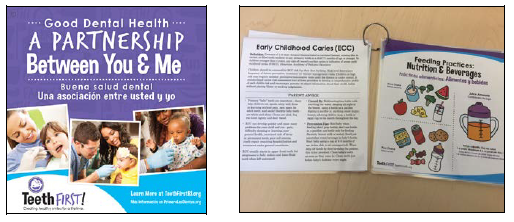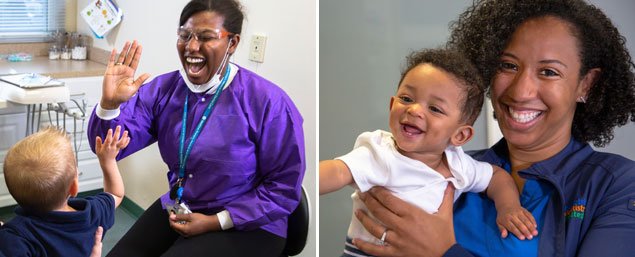According to the Centers for Disease Control and Prevention, early childhood caries and the associated serious health consequences are the most prevalent infectious disease among children in the U.S. However, children who are seen as soon as a first tooth erupts, or by age one, have significantly less occurrence of dental disease throughout childhood than children who are seen later in life.
As incidence of very early childhood dental disease rises, there is a shortage of dentists who are willing to see children under age three. Although treating very young children is different from treating older children, it’s not as difficult as it may seem. There are many strategies you can use to help create a child-friendly practice and make the experience a pleasant one for you, your young patients, and their families.
Consider opening your practice to young children and put them on the path to healthy smiles for a lifetime!
Current clinical guidelines recommend that a child’s first dental visit occur within six months of eruption of the first tooth and no later than 12 months of age.
National Associations
Rhode Island Resources
-
Comprehensive oral care that includes both emergency and preventive services
-
Assessment for oral diseases and conditions
-
Individualized preventive dental health plan based on a caries-risk assessment and a risk assessment for periodontal disease
-
A plan for acute care
-
Anticipatory guidance about teething, use of sippy cups, thumb sucking or pacifier habits
-
Information about care of teeth and gums
-
Referrals to specialists
-
Nutritional counseling
-
Fluoride varnish application for moderate to high-risk children twice a year
Click here to learn more about professional development opportunities for you and your staff.
It’s important that children feel welcome as soon as they enter your office. There’s no need to make major renovations or purchase special equipment since adding a few child-friendly elements to your existing office is all you need. Fairly simple and inexpensive things will entertain children and help make them feel comfortable.
Here are a few child-friendly elements to consider:
-
Small-scaled furniture with books and durable, safe toys in the waiting room
-
A television set playing children’s television shows
-
Children’s magazines
-
Fun and educational wall murals and posters placed at a child’s eye level
-
Brightly colored patient bibs
-
Whimsical bib clips
-
Colored and flavored gloves
-
Child sized toothbrushes
-
Video games available to play on the television in the exam room
-
A prize box for rewarding good patients
-
A mascot such as a stuffed animal or a puppet to act as a good-will ambassador and to help you demonstrate techniques and procedures to children.
Not all of these things are necessary for your practice to become child-friendly, but choosing a few of them will go a long way toward making even the youngest patient feel right at home.
All of the young children that you see will have a parent or other family member with them during the visit. While you will be examining the child, most of your communication regarding prevention, treatment, and home care will be with the parent.
Consider these family-friendly strategies:
-
Have a seat available for family members
-
Let the parent know when you need them to help. For very young children, it could be holding them in their lap and then laying them backward while holding their hands. For slightly older children who are being treated in a chair, this could be holding the child’s hand(s), placing a reassuring hand on them, or encouraging them to be as still and cooperative as possible
-
Let the parent know that their child may cry when you are examining their mouth and teeth and that it’s okay. You aren’t hurting them, you can get a good look, and it’s over quickly. Allow time at the end of the exam for the parent to talk with you and for the child to connect with you so that everyone leaves on a positive note
-
Ask open-ended questions to encourage honest answers and use them as a way to initiate conversations with the parent
-
Work with your team to come up with proactive ways to entertain the child while you talk with the parent, including letting them hold a toothbrush, small toy, or balloon
Developed with Rhode Island dental care providers, Good Dental Health: A Partnership Between You & Me covers the basics of good oral health. Each page is double sided and designed as a hands-on teaching tool:
-
The patient-facing pages feature clear, simple text (in English and Spanish) and engaging pictures and illustrations to educate families.
-
On the back of the patient–facing pages are helpful conversation guidelines for providers (English).
-
The pages are laminated (making them wipeable for infection control) and bound with a metal ring that is easily opened to remove or re-order pages to your preference.

Oral health topics covered include:
-
How does a cavity form?
-
Early Childhood Caries
-
Feeding practices: Nutrition & beverages
-
Seal away the tooth decay
-
Toothbrushing tips
-
Make clean teeth a habit
-
Fluoride fights cavities
The tool also includes an interactive ‘Oral Health Goals for Your Family’ chart, which will help you establish self-management goals for your patients to work on while at home.
If you would like to order free copies of the Good Dental Health: A Partnership Between You & Me, please use this Order Form. If you have any questions or would like additional information, please contact TeethFirst! at info@TeethFirstRI.org or (401) 351-9400.







